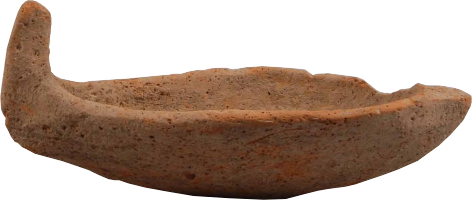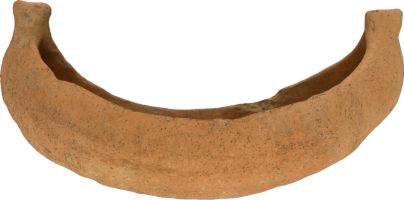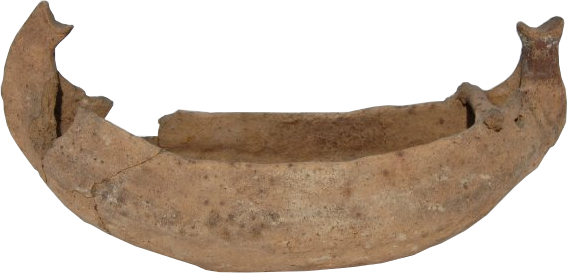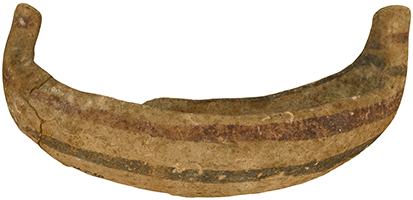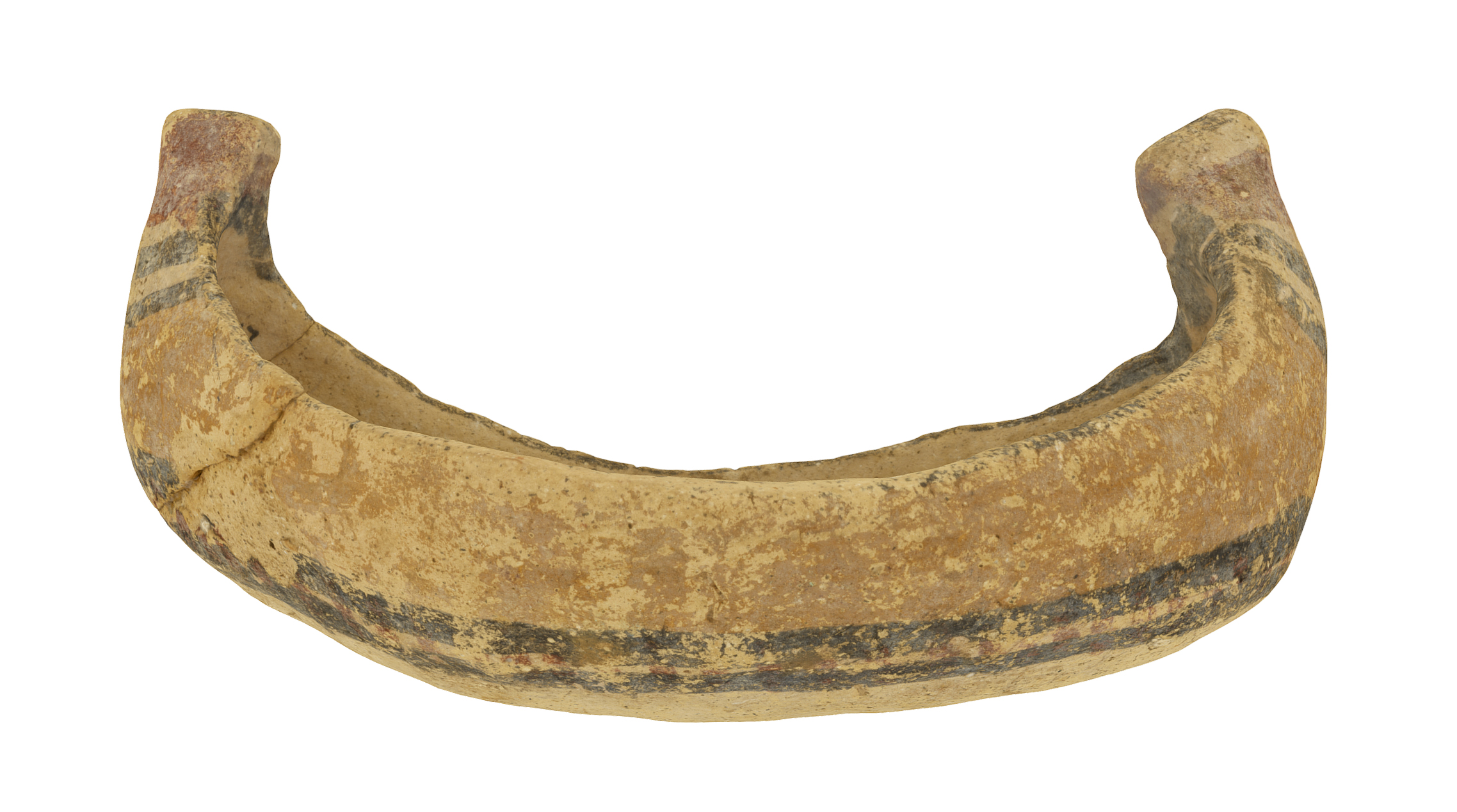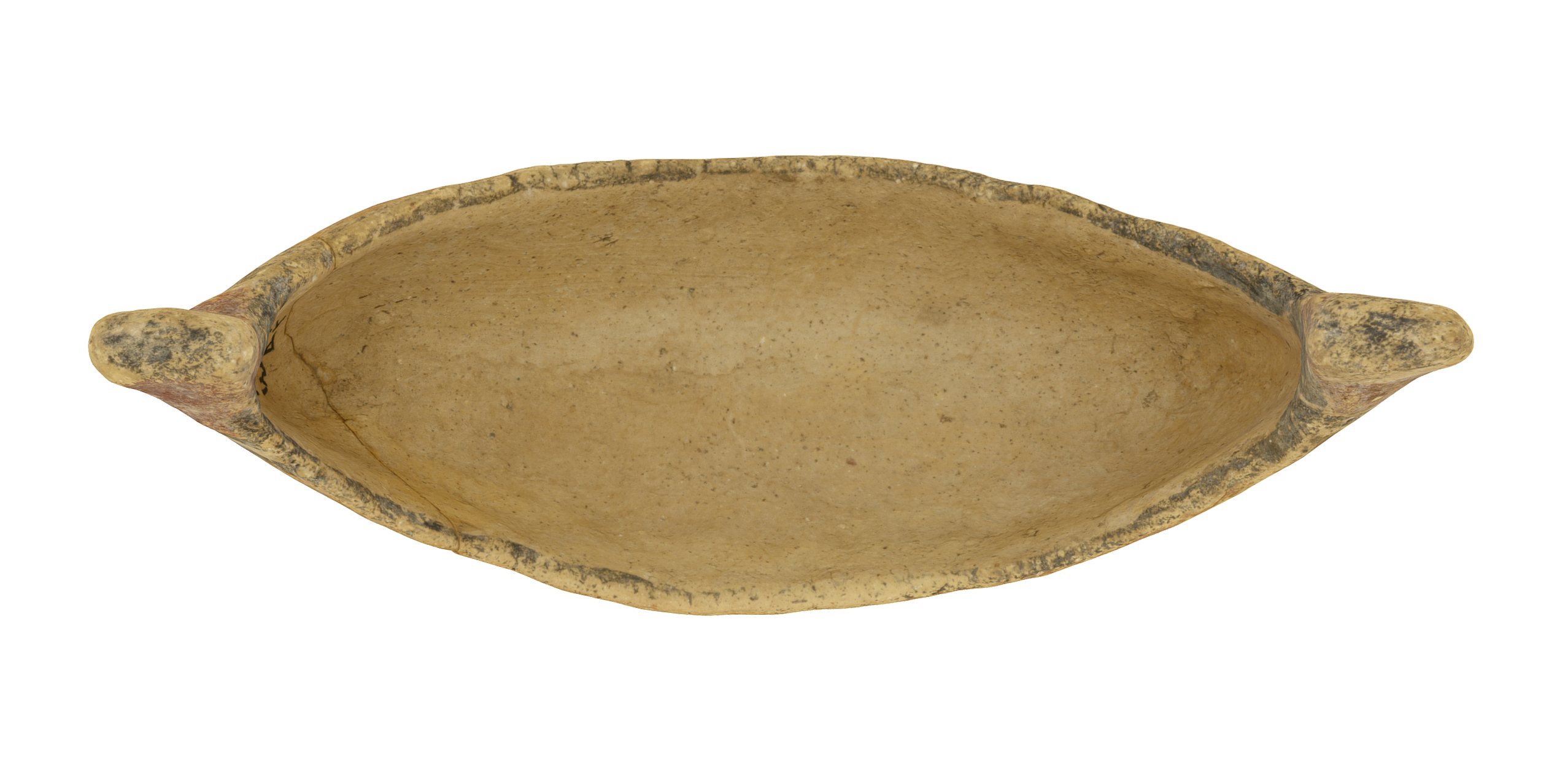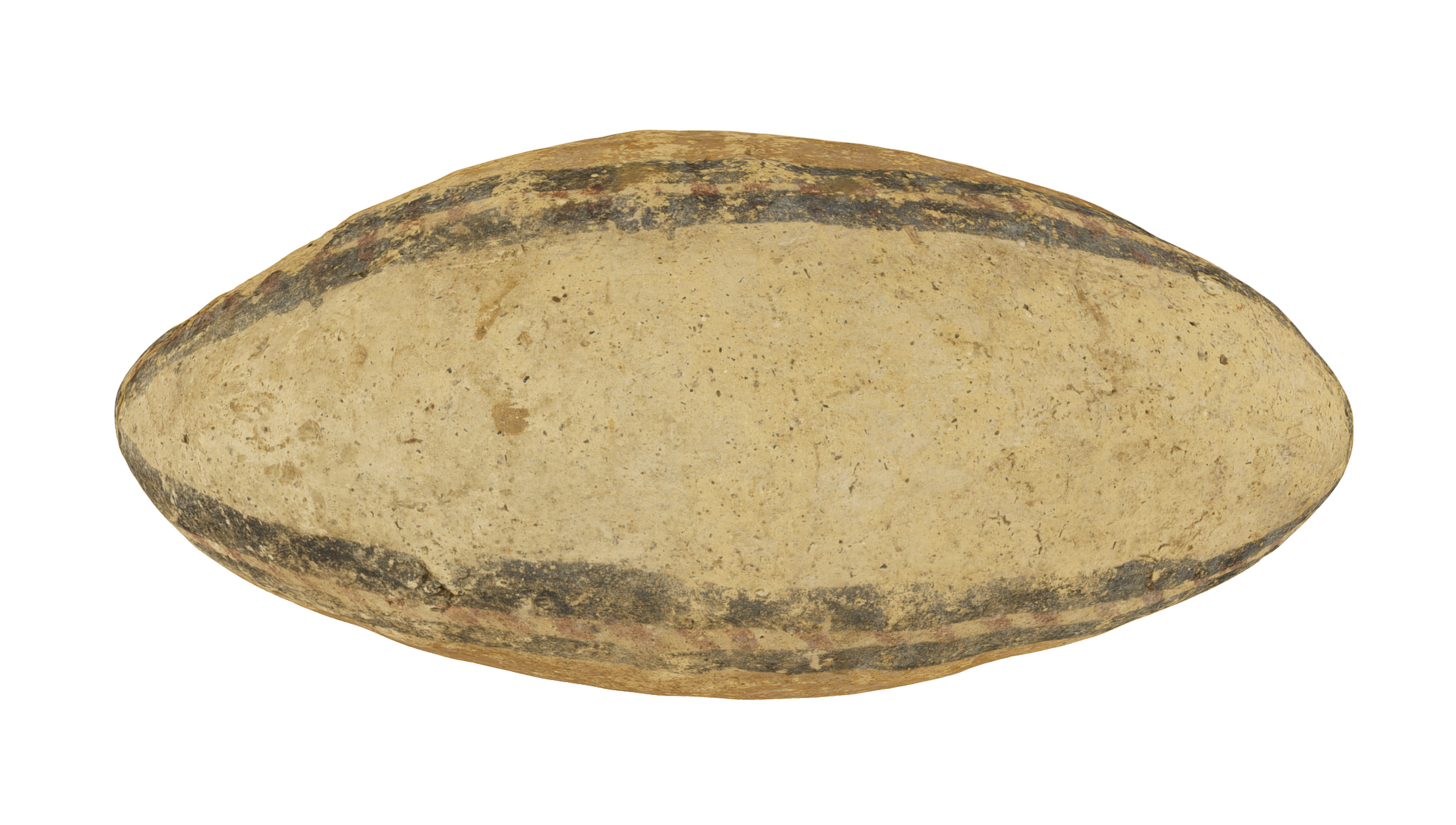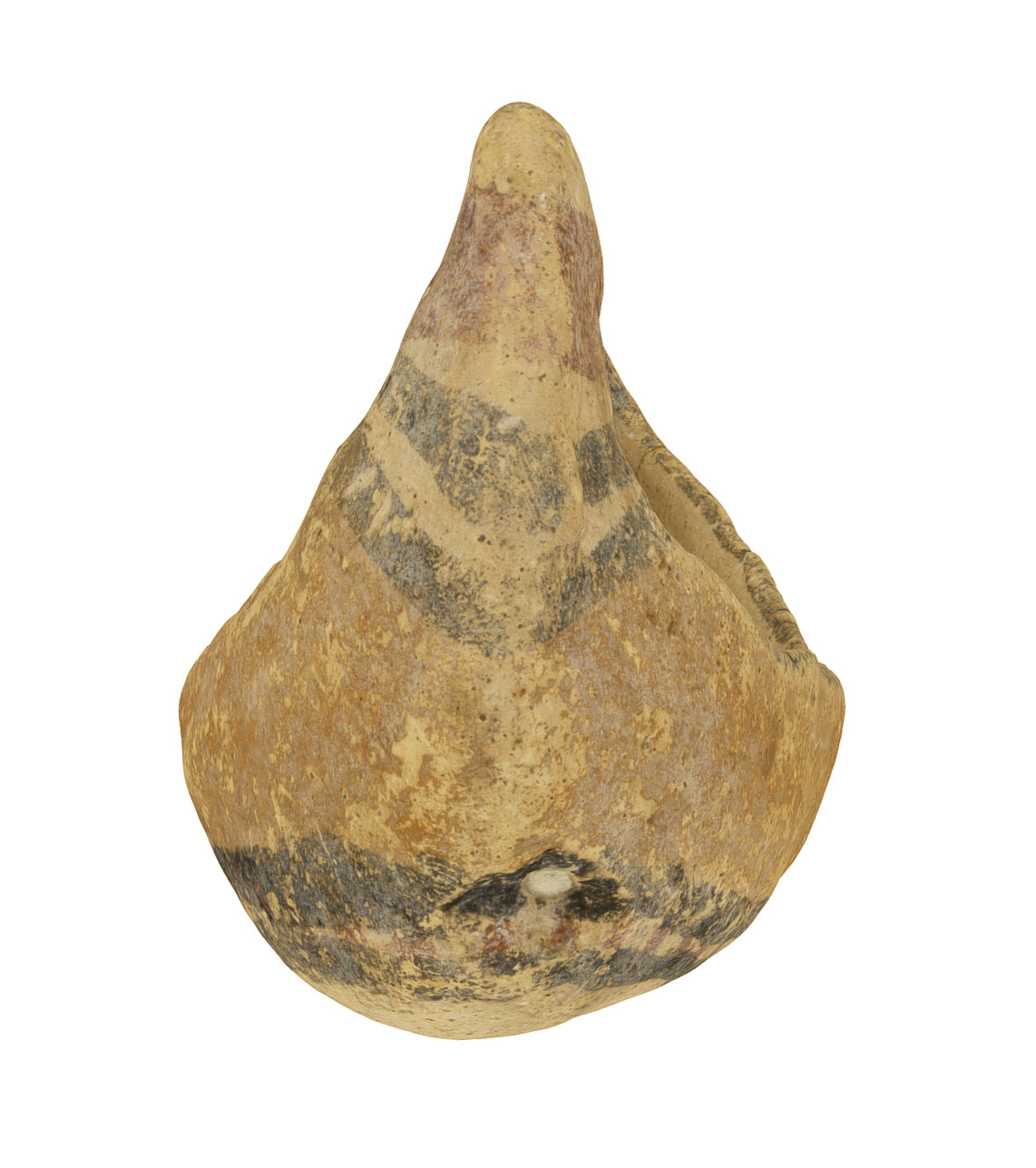Crescent shaped hull with a concave, uneven gunwale and roughly symmetrical posts ending in a flat undecorated top. One of the stemposts rises vertically, while the other is slightly incurving. The vessel has a painted decoration on the outside consisting of back and red bands, including horizontal parallel lines on the posts above gunwale level.
Ship model
C30
Cypro-Geometric I-II (first half of 10th century)
Amathus, west cemetery, tomb 521
L: 14.4 cm; H: 7.1 cm; W: 6.4 cm
terracotta boat model with painted decoration in red and black
Limassol district Museum AM 521
Karageorghis 1987b: 716-719, fig. 173; Karageorghis 1993: 74, no. GK(ii)5; Karageorghis and Iacovou 1990 (tomb)
Tomb 521 was constructed towards the end of CG IB (first half of the 10th century BC), which makes it ones of the earliest CG tomb groups to come to light from Amathus. It is an L-shaped chamber tomb, with an oblong rectangular chamber and a narrow dromos which lies off the chamber's central axis, to the right of its south long side. The chamber's dimensions are 3.6 m east-west and 1.65 m north-south, with a maximum height of 1.85 m after its roof was bulldozed off. Along the south side of the chamber was a bench serving as a kline for the deceased (2.2 m long, 70 cm wide and 22 cm high) made of four courses of limestone slabs with smaller stones in between. A human skull was the only surviving skeletal evidence, situated east of the bench and close to the stomion. The dromos (2.3 m long, 80-85 cm wide) had its entrance cut by a bulldozer. Directly east of the stomion where the dromos enters the chamber was a nearly square recess (65 x 55 cm). The stomion was blocked using two rectangular slabs - a smaller and a larger one - with smaller stones serving as filler between them. Burial good were found all over the floor of the chamber, with none from the dromos or the recess. A total of 105 objects were recovered, of which 91 are clay vessels and 14 are small objects of metal or stone. The tomb was used during two different periods: Cypro-Geometric and Cypro-Archaic respectively. The re-use of CG tombs during the Cypro-Archaic period is a common phenomenon at Amathus. Associated with the primary use of the tomb is a group of 54 ceramics, while 37 vases have been assigned to the Cypro-Archaic (end of CAI-beginning of CA II). It is noted that the two burial groups were found mixed together throughout the chamber. Rather than clearing away the earlier grave goods into a corner to make room for the later deposition, three quarters of the CG vessels and the majority of the CA vessels were all concentrated in the innermost western half of the chamber and on the kline.
The CG vessels belong to four different categories, three of which are local and one imported from the Levant. Local wares include WP I-II (17), Bichrome I-II (19) and Black Slip I-II (9). The imports (9) are Levantine pilgrim flasks, including monochrome (3), bichrome (4) and polychrome (2) wares. Typologically, closed vessel predominate, with 39 closed versus 13 open shapes. In addition to pottery, there a number of notable terracotta shapes, including two unprecedented box-pyxides (one of which is pictorial), two typologically peculiar bichrome ware askoi, a ring kernos, and a rare specimen of a strainer bowl simulating a bronze prototype. The two askoi are unusual due to the presence of lug legs and the unparalleled array of spouts on their shoulders. One of them (no. 83) is furthermore unique in light of its anthropomorphic spout in the shape of a female figure carrying an amphoroid krater oh her head. The ring kernos has an animal spout, two pomegranates and a miniature amphora. The askoi and kernos are considered to be the product of the same workshop based on a number of considerations. These items highlight both the originality and liveness of Amathusian terracotta workshops during CGI. Other finds of note include two iron daggers with bronze rivets, one of which carries traces of ivory in its haft. Karageorghis and Iacovou note that tomb 521 shows that during CG, Amathus participated in a homogeneous Cypro-Geometric culture, as evidenced by the tomb architecture, burial customs, as well as the types of local and imported pottery. The high percentage of imported Levantine pilgrim flasks underscores an important maritime connection.
The boat model was originally considered to belong to the second CA phase, but was later correctly attributed to the initial CG I burials.
Karageorghis, V. 1987b. “Chronique des fouilles et découvertes archéologiques à Chypre en 1986, “BCH 111.2: 663-733.
―――. 1993.The Coroplastic Art of Ancient Cyprus II, Late Cypriote II-Cypro-Geometric III. Nicosia: A.G. Leventis Foundation.
Karageorghis, V. and M. Iacovou. 1990. “Amathus Tomb 521. A Cypro-Geometric I Group,” RDAC: 75-100.


